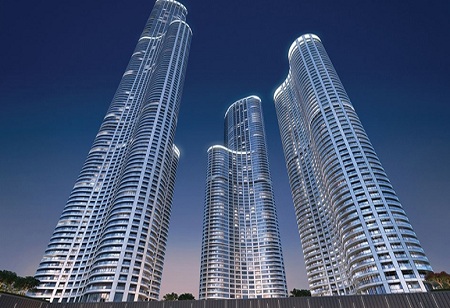
A report by CBRE South Asia has showed that nearly 77 percent of tall buildings in India are located in the financial capital Mumbai. The report also states that the city also commands premium prices compared to most other cities which also makes construction of tall buildings economically viable. In the report titled, ‘Sky is the limit – Rise of tall buildings in India,’ after Mumbai, cities like Hyderabad, Kolkata, Noida, Gurgaon, Bangalore, Chennai rank in the list of tall buildings in India. Hyderabad has 8 percent share, Kolkata has 7 percent, Noida has 5 percent, while Gurgaon, Bangalore and Chennai all have 1 percent share of tall buildings.
As per the report, Mumbai has more than 100 tall buildings at height of 150m and above. It ranks ranks 17th worldwide and 14th in Asia. Hong Kong has one of the highest number of tall buildings in the world followed by Shenzhen, New York City, Dubai, Guangzhou, Shanghai, Tokyo.
The residential building Usha Kiran in Mumbai which was completed in 1961 was the first tall building in India with a height of 80 m. After 1970, a few more tall buildings were built such as Subhash Chandra Bose Tower in Kolkata, and Oberoi Trident and Air India Building in Mumbai, but the construction of tall buildings accelerated in India only after 2000, the report states.
As per the report, the prime reasons that spurred the development of tall buildings in Mumbai was the exponential increase in urban population along with wealth accumulation among its population. It also stated that decentralization in growth led to the expansion of the city towards north and east, leading to the emergence of new micro-markets such as Malad and Goregaon in the Western Suburbs, and Powai, Vikhroli and Kanjurmarg in the Eastern Suburbs.
High-rise clusters in Mumbai emerged in Central Mumbai and South Mumbai are not only well connected via public transport and roadways to other parts of the city but also command a premium in real estate prices compared to other parts of the city. Furthermore, the report also states that more than 90 percent of tall buildings in India are residential whereas only 5 percent are office buildings.
Stating reasons for less number of office towers in India, the cumulative water and electricity requirement per head per day is much higher than a residential building due to a higher number of occupants. Another reason the report state is Public safety. The average number of occupants per floor in a residential tall building is much lower compared to an office building, so, evacuating in a residential building in case of a hazard is comparatively easier
We use cookies to ensure you get the best experience on our website. Read more...
Copyright © 2025 HomesIndiaMagazine. All Rights Reserved.